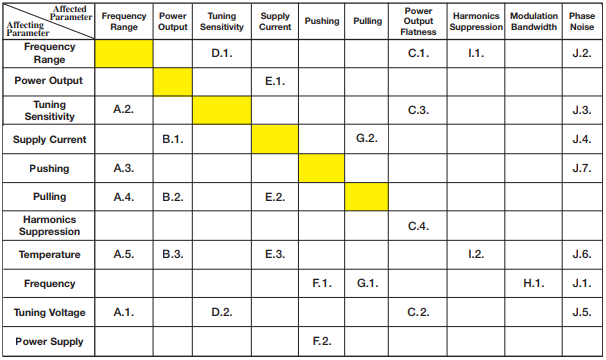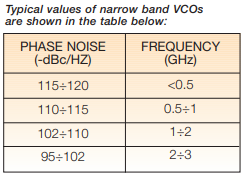How VCO Parameters Affect Each Other
Relationships of VCO Performance Parameters

- Go to the intersection on the table between the Affecting and Affected parameters ( for example, the intersection of how "Frequency Range" affects "Phase Noise" is J.2.").
- The figure appearing in the intersection ("J.2." in our example ) indicates where the explanation on the Effect appears in the text: the letter indicates the Article and the number indicates the Sub-Article (for example, "J.2." refers to Article "J", Sub-Article "2").
- Empty cells indicate that the effect of the Affecting Parameter on the Affected Parameter is insignificant or does not exist at all.
A. Parameters Affecting VCO Frequency Range The following parameters affect the VCO Frequency Range.
A.1. TUNING VOLTAGE
• An increase in tuning voltage range widens frequency range.
A.2. TUNING SENSITIVITY
• Lower sensitivity means a narrower frequency range for a given range of tuning voltage.
A.3. PUSHING
• Increased pushing causes decreased effective frequency range
A.4. PULLING
• Increased pulling causes decreased effective frequency range.
A.5. TEMPERATURE
• An increase in the range of the ambient operating temperature causes a decrease in the VCO's frequency range and vice-versa.
B. Parameters Affecting VCO Power Output. The following parameters affect the VCO Power Output:
B.1. SUPPLY CURRENT
• Increasing supply current typically increases power output
B.2. PULLING• To improve pulling, output power should be reduced by connecting an attenuation circuit at the VCO output.
• Improved pulling can also be achieved by connecting a buffer amplifier at the VCO output port. However, this buffer amplifier requires a higher supply current.
B.3. TEMPERATURE
• From an ambient temp of +25°C: a temp increase to +85°C results in an output power decrease of 0.5dB to 1.0dB typically
• From an ambient temp of +25°C: a temp decrease to -55°C results in an output power increase of 0.5dB to 1.0dB typically.
C. Parameters Affecting VCO's Power Output Flatness The following parameters affect the VCO Power Output Flatness:
C.1. FREQUENCY BANDWIDTH
• As the VCO frequency range is increased, the difficulty to achieve a flat output power is increased.
C.2. TUNING VOLTAGE
• As the tuning voltage range is reduced and narrowed, a flatter output power can be achieved.
C.3. TUNING SENSITIVITY
• It is more difficult to achieve flat output power for high tuning sensitivity than for low tuning sensitivity.
C.4. HARMONICS
• Adding an output filter to suppress harmonics may in some cases degrade power output flatness.
D. Parameters Affecting VCO Tuning Sensitivity The following parameters affect the VCO Tuning Sensitivity:
D.1. FREQUENCY RANGE
• For a given tuning voltage range, increasing the frequency range requires an increase in the tuning sensitivity, and vice-versa.
D.2. TUNING VOLTAGE
• For a given frequency range, increasing the tuning voltage range decreases the tuning sensitivity, and vice-versa.
E. Parameters Affecting VCO Supply Current The following parameters affect the VCO Supply Current:
E.1. POWER OUTPUT
• Increasing power output requires higher supply current.
E.2. PULLING
• Same as B.2.
E.3. TEMPERATURE
• From an ambient temp of +25°C: a temp increase to +85°C typically results in a supply current increase of approximately 10%.
• From an ambient temp of +25°C: a temp decrease to -55°C typically results in a supply current decrease of approximately 10%.
F. Parameters Affecting VCO Pushing The following parameters affect the VCO Pushing:
F.1. FREQUENCY
• As the VCO frequency increases, difficulty in achieving good pushing is increased.
F.2. POWER SUPPLY
• Good pushing is easier to achieve in designs with high current.
G. Parameters Affecting VCO Pulling The following parameters affect the VCO Pulling:
G.1. FREQUENCY
• As the VCO frequency increases, difficulty in achieving good pulling is increased.
• See B.2.
G.2. SUPPLY CURRENT
• It is difficult to achieve good pulling when there is a limit on supply current consumption, due to the fact that (connecting a buffer amplifier at the VCO output port) improving pulling increases current consumption.
H. Parameters Affecting VCO Modulation Bandwidth The following parameters affect the VCO Modulation Bandwidth:
H.1. FREQUENCY
• Higher modulation bandwidth can easily be achieved at higher frequency.
I. Parameters Affecting VCO Harmonics Suppression The following parameters affect VCO Harmonics Suppression:
I.1. FREQUENCY BANDWIDTH
• It is easier to achieve good harmonics suppression when frequency range is narrow.
I.2. TEMPERATURE
• With ambient temperature increase, the harmonic level gets lower. With ambient temperature decrease, the harmonic level gets higher.
J. Parameters Affecting VCO Phase Noise The following parameters affect VCO Phase Noise:
J.1. FREQUENCY
• As carrier frequency increases, it's more difficult to achieve good phase noise.
J.2. FREQUENCY RANGE
• It's easy to achieve good phase noise when frequency range is narrow.
J.3. TUNING SENSITIVITY
• Increasing the tuning sensitivity degrades phase noise and vice-versa.
J.4. SUPPLY CURRENT
• It is typically easy to achieve good phase noise at higher offset frequencies (> 1kHz) in designs with a high supply current.
J.5. TUNING VOLTAGE
• For a given frequency range it is typically easy to achieve good phase noise in designs with a wide tuning voltage range.
J.6. TEMPERATURE
• Phase noise varies typically by 3dB in the -55°C to +85°C range.
J.7. PUSHING
• High pushing can cause phase noise degradation due to increased sensitivity to the power supply noise.



